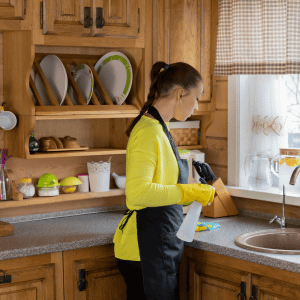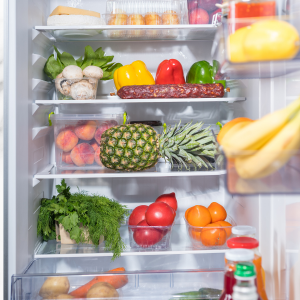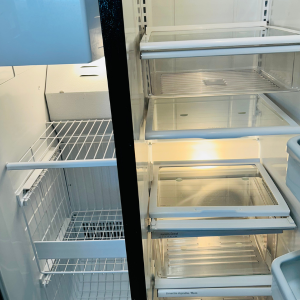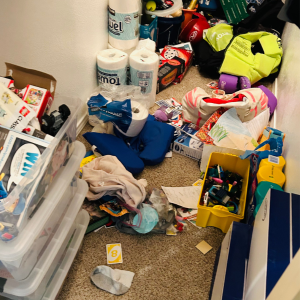The kitchen is the most frequented area in the house since it is where we prepare and serve food. However, the kitchen can harbor hidden dirt and germs in various areas that often go overlooked during regular cleaning routines.
This post will highlight the 22 dirtiest spots in your kitchen, providing insights into why they can be breeding grounds for bacteria and offering practical tips on keeping them clean. Let’s dive into this essential kitchen cleaning guide!
Refrigerator Seal
We overlook the refrigerator seal, yet it can accumulate grime, crumbs, and bacteria if unchecked. Wipe the seal regularly with a clean, damp microfiber cloth to prevent the growth of bacteria and ensure airtight sealing.
Sink drain
Food particles, grease, and residue accumulate in the sink drain, leading to unpleasant odors and potential clogs. Use a mixture of water and baking soda or vinegar to flush the drain regularly and keep it fresh and clean.
Cutting Boards

Cutting boards, especially wooden ones, can harbor bacteria due to their frequent use. After each use, wash /clean them thoroughly with hot, soapy water and periodically disinfect them with hot water and a detergent or mixture of equal parts of water and vinegar.
Dish Rack
The dish rack is a breeding ground for mold due to constant exposure to moisture. Regularly clean and disinfect it using a diluted vinegar solution, and ensure it is free from scorched pot residue before putting clean dishes.
Coffee Maker
The water reservoir and coffee pot provide ideal conditions for bacteria and mold to grow. Clean the coffee maker frequently by running a mixture of equal parts clean water and vinegar through it, followed by a plain water cycle to remove residual vinegar.
Oven Knobs
Oven knobs can quickly become grimy since we touch them frequently with unwashed hands. Wipe them down regularly with a disinfectant to prevent the spread of germs.
Microwave Interior
Food spills and stains in the microwave can lead to foul odors and bacterial growth. Clean the interior with water and vinegar or microwave-safe cleansing agents, ensuring no food remnants are left behind.
Blender Seals
Blenders often have removable seals that can trap food particles and breed mold. Thoroughly clean and disinfect these seals after each use, allowing them to air dry before reassembling.
Garbage Can
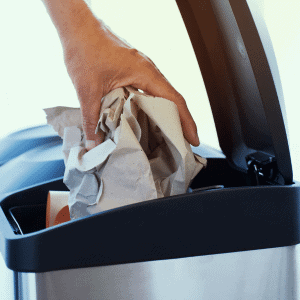
A frequently used and rarely cleaned garbage can is a potential hotbed for bacteria. Regularly remove trash, clean the can with a mild detergent, and consider using trash bags to keep the interior cleaner.
Kitchen Sponge
Sponges are notorious for harboring bacteria, so it is crucial to sanitize them regularly. Rinse well after each use, and microwave damp sponges for approximately two minutes to kill bacteria.
Overhead Range Hood
The range hood, commonly overlooked during cleaning, accumulates grease and grime. Wipe its surface with a degreaser, and remove and clean the filter per the manufacturer’s instructions.
Spice Jars
Spice jars can quickly become sticky with food remnants and attract insects. Regularly wipe them clean and ensure they are tightly closed to maintain freshness and prevent contamination.
Cabinet Handles and knobs
Similar to oven knobs, cabinet handles are the dirtiest spots in your house touched frequently and can harbor germs. Wipe them down regularly with a disinfectant to keep them clean and hygienic.
Toaster Crumbs
Toasters accumulate crumbs over time, creating a haven for bacteria. Regularly empty the crumb tray and clean the interior by turning it upside down and gently shaking out any loose particles.
Blender Base
The Blender base can create one of the dirtiest sports in your kitchen when it accumulate sticky residue and dirt around it. Before cleaning, ensure it is unplugged, and wipe it down carefully with a damp cloth or sponge.
Pet Bowls
We often overlook the pet bowls, probably because we do not use them, but unfortunately, they can be a breeding place for bacteria and germs that can cause serious health problems for you or your pet. Wash pet bowls immediately after your pet finishes eating to avoid the growth of bacteria.
Utensils
Utensils that do not dry well after cleaning can create suitable breeding places for bacteria. Cross-contamination can also occur when preparing different foods using the same utensils.
For example, using the same cutting board for cutting raw meat and vegetables without washing it in between can transfer bacteria from the raw meat to the fresh vegetables. Use separate utensils for storing different types of food. Clean utensils immediately after each use and dry them thoroughly before storing them.
Reusable Food storage containers
These are among the dirtiest spots in your kitchen which we do not clean frequently and store appropriately; hence, they can act as breeding places for bacteria. Containers that are not airtight or have cracked seals can allow bacteria or mold from the air to contaminate the food.
Store food in a clean, airtight container.
Countertops
Raw foods like meat, poultry, and seafood may contain harmful bacteria like salmonella or E. coli. Suppose these foods come in contact with countertops and are not sanitized; In that case, the bacteria can transfer to other surfaces and multiply. Sanitize and dry countertops that come in contact with the food prepared.
Cookbooks
Most people love displaying and referring to recipes from their favorite cookbooks when preparing food. Unfortunately, in the process, they flip pages in between while handling the food simultaneously, which may contaminate the food being prepared, cause spills, and leave stains on the cookbook. Cookbooks stored in dusty areas can also become breeding places for bacteria.
Store cookbooks in a clean area, away from food, moisture, and dust. Keep them upright to minimize contact with surfaces.
Kitchen towels
Bacteria thrive in warm and moist environments. Kitchen towels, if not adequately dried or stored in a damp area, can provide favorable conditions for the growth of bacteria.
Kitchen towels can quickly spread bacteria from one surface to another if not adequately cleaned or used without sanitizing them between uses. For example, if you use a towel to wipe dirty surfaces and use it to wipe clean dishes.
Regularly sanitize kitchen towels by washing them in hot water and a detergent. Allow kitchen towels to completely dry before reusing them. Avoid using the same towels for different tasks or surfaces without sanitizing in between.
Cleaning products
If cleaning products are not properly stored or used correctly or are inadequate in killing bacteria, they may only spread the germs instead of eliminating them. This can contribute to the accumulation and spread of bacteria on kitchen surfaces.
Use effective eco-friendly cleaning products to sanitize surfaces. Follow the instructions on cleaning product labels.
These dirtiest spots in your kitchen need frequent cleaning and or sanitization to keep them spotless and well organized.This will minimize the growth of harmful bacteria and germs in your house.

